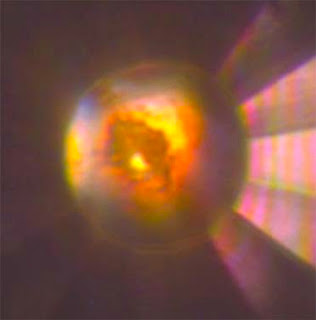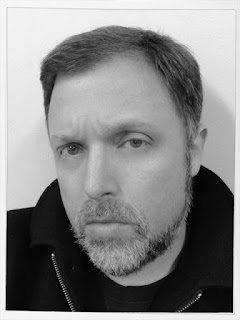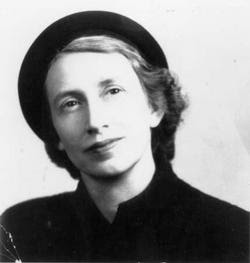| Image Source: Futurism |
Topics: Biology, Exobiology, Exoplanets, Futurism, Mars, Space Exploration
| Image Source: Futurism |
Topics: Biology, Exobiology, Exoplanets, Futurism, Mars, Space Exploration
 |
| The sample appears as a dark area near the center of this micrograph of the diamond-anvil cell. Credit: X. Dong et al. Nat. Chem. 2017 |
Scientific American: Helium compound may form under pressure, Andrew Grant
It would literally be decades before we found out this was a part of African American History, as the book and movie "Hidden Figures" reveals. We have been, and always will be a part of the fabric of this nation's progress forward. Regarding us as lazy, stupid, useless can only lead to the United States regression into third world status. It has the logic of shooting oneself in the foot and expecting "the other" to feel the pain.
I guess for my mother, it was t-minus six months and counting (I was happily gestating in her womb)...
50 years later: Godspeed, John Glenn
 |
| Members of the Kappa Beta Chapter of Kappa Alpha Psi Fraternity, Inc perform a step show at the University of Memphis in 1999 Note that the average cane is about knee high (app. 2 feet), image source at site |
Topics: African Americans, History, Diaspora, Diversity in Science, Women in Science
Step Afrika: What is Stepping?
The Art of Stepping: History of the Art of Stepping
University of Florida Multicultural Guide: What is Strolling?
Wikipedia: Gumboot dance
Wikipedia: Stepping (African-American)
Kappas on YouTube (Hey, I'm a member, so I'm GOING to be partial):
Howard Homecoming
Maniac Drew Brown (Cane Master)
Southern Province Step Show
The Art of Twirling
University of Miami, TEDx
 |
| The Sun as seen by the Solar Dynamics Observatory (Courtesy: Solar Dynamics Observatory/NASA) |
Physics World: Photons are a drag on the Sun, Keith Cooper
Imagine an Earth where Africa was never colonized and ended up ruling the world. We did. Legends Parallel issue 2 is coming soon. Pre-order yours via the STORE link at www.LegendsParallel.com
Uzziah is a hero on Earth 2. The problem that Earth has with him is he keeps saving people nobody really wants to save. What will happen to his, and their, worldview when they find out the losers he's saving here are leaders elsewhere?
 |
| Replica of Benjamin Banneker's clock at Brookhaven National Laboratory link below |
Brookhaven National Laboratory: Benjamin Banneker
Banneker Store: About Benjamin Banneker
 |
| An electromagnetic wave traveling from left to right (positive x direction). Image Credit: Supermanu (CC BY-SA 3.0) |
Topics: Astrophysics, Electromagnetic Wave, Neutron Stars, Quantum Electrodynamics
Physics Central: Neutron Stars: Cosmic Laboratories for Quantum Physics, H.M. Doss
 |
| Tim Wise, whom scholar and philosopher Cornel West calls, “A vanilla brother in the tradition of (abolitionist) John Brown," more in the bio below. |
Topics: African Americans, History, Diaspora, Diversity in Science, Women in Science
Topics: Einstein, General Relativity, Special Relativity
The long answer on “c”: http://math.ucr.edu/home/baez/physics/Relativity/SpeedOfLight/c.html
Wolfram Physics
Special Relativity
General Relativity
http://www.cafepress.com/cp/customize/product2.aspx?number=1555993225
 |
| Image Source: Link below |
Topics: Civil Engineering, Politics, Weather
Look at California (Look at California)
Look at California (Look at California)
The rollin' hills seem to do something for you
It seems there meant to be looked on by you
And when the sunshine is doing it's thing
Then you know that all you see is true
Every day every night the same old groovy feelin
People that live a lot love a lot
And everything there is so good
Look at California
Look at California
All the flowers are bloomin' all about
Every kind you and I could think of
And if you see anything that's missin'
Then they make it up to you with love
Whether up or whether down
It don't even mean a thing
Look at the things around
The peace you've found
And all that you feel is so real
Look at California
Look at California
Look at California
Look at California
Discovery Magazine:
California rivers are so swollen from runoff that the impact is easily seen in these before and after satellite images
Tom Yulsman
 |
| Paperback book cover, see links below |
 |
| Image credits: Composite image by Yuen Yiu, Staff Writer and Abigail Malate, Staff Illustrator. Fiber-Optic photo by Matthew.nq/Wikimedia , (CC by 4.0) |
Inside Science: Same Spark, More Bytes, Yuen Yiu
My Question To You, Is This:
"Is Scrivener In The Technical Position To Be Controlled, From Multiple Apple Devices; Particularly With My MAC Desktop and iPad? And If So, Can You Provide Me A Link, Explaining How?"
Thank You, In Advance.
Rebeca Schiller: The only way to control it is through dropbox. If j
ME: I'll look into drop 'Dropbox.' Thank You. What do mean "If j" ?
Rebeca Schiller: if you go to simplyscrivener.com, I have tutorial about setting it up on the iPad. Once it's setup you can access your projects from anywhere.
I keep hitting send too soon and didn't finish the sentence. That was the if j
Me: Understood. I sent you a link earlier this morning, as well. Please disregard that. I'll check in on the link after work. Once again, thank you for your time.
Sent an email, earlier this morning.
Auto correct changed the word email to Link.
Rebeca Schiller My pleasure!
I'll Post The Link Below, (Man, i am Saying That Word Too Much), Where Rebeca Schiller Goes Into Detail, With Pictures, How This Feat Is Accomplish.
But Just For A Second, Imagine..
 |
| An early book cover at Open Library |
 |
| Photo of Lillian Smith at the Blog: "stuff white people do" (ahem: by a white guy, on hiatus since 2010) |
"Killers of the Dream," by Lillian Smith